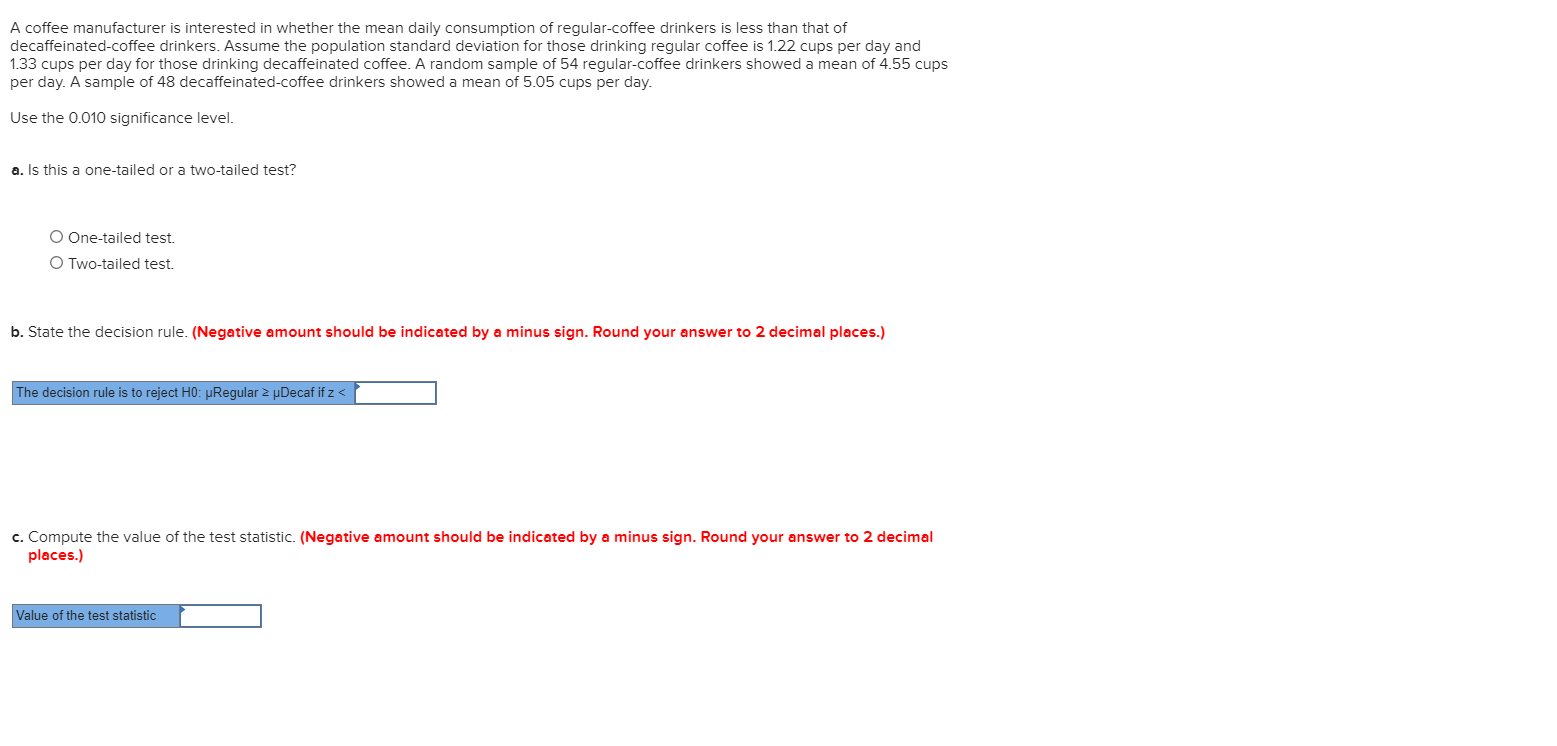A coffee manufacturer is interested in whether the mean daily consumption of regular-coffee drinkers is less than that of decaffeinated-coffee drinkers. Assume the population standard deviation for those drinking regular coffee is 1.22 cups per day and 1.33 cups per day for those drinking decaffeinated coffee. A random sample of 54 regular-coffee drinkers showed a mean of 4.55 cups per day. A sample of 48 decaffeinated-coffee drinkers showed a mean of 5.05 cups per day. Use the 0.010 significance level. a. Is this a one-tailed or a two-tailed test? O One-tailed test. O Two-tailed test. b. State the decision rule. (Negative amount should be indicated by a minus sign. Round your answer to 2 decimal places.) The decision rule is to reject H0: µRegular 2 µDecaf if z < c. Compute the value of the test statistic. (Negative amount should be indicated by a minus sign. Round your answer to 2 decimal places.) Value of the test statistic
A coffee manufacturer is interested in whether the mean daily consumption of regular-coffee drinkers is less than that of decaffeinated-coffee drinkers. Assume the population standard deviation for those drinking regular coffee is 1.22 cups per day and 1.33 cups per day for those drinking decaffeinated coffee. A random sample of 54 regular-coffee drinkers showed a mean of 4.55 cups per day. A sample of 48 decaffeinated-coffee drinkers showed a mean of 5.05 cups per day. Use the 0.010 significance level. a. Is this a one-tailed or a two-tailed test? O One-tailed test. O Two-tailed test. b. State the decision rule. (Negative amount should be indicated by a minus sign. Round your answer to 2 decimal places.) The decision rule is to reject H0: µRegular 2 µDecaf if z < c. Compute the value of the test statistic. (Negative amount should be indicated by a minus sign. Round your answer to 2 decimal places.) Value of the test statistic
MATLAB: An Introduction with Applications
6th Edition
ISBN:9781119256830
Author:Amos Gilat
Publisher:Amos Gilat
Chapter1: Starting With Matlab
Section: Chapter Questions
Problem 1P
Related questions
Topic Video
Question

Transcribed Image Text:A coffee manufacturer is interested in whether the mean daily consumption of regular-coffee drinkers is less than that of
decaffeinated-coffee drinkers. Assume the population standard deviation for those drinking regular coffee is 1.22 cups per day and
1.33 cups per day for those drinking decaffeinated coffee. A random sample of 54 regular-coffee drinkers showed a mean of 4.55 cups
per day. A sample of 48 decaffeinated-coffee drinkers showed a mean of 5.05 cups per day.
Use the 0.010 significance level.
a. Is this a one-tailed or a two-tailed test?
O One-tailed test.
O Two-tailed test.
b. State the decision rule. (Negative amount should be indicated by a minus sign. Round your answer to 2 decimal places.)
The decision rule is to reject H0: µRegular 2 µDecaf if z <
c. Compute the value of the test statistic. (Negative amount should be indicated by a minus sign. Round your answer to 2 decimal
places.)
Value of the test statistic

Expert Solution
This question has been solved!
Explore an expertly crafted, step-by-step solution for a thorough understanding of key concepts.
This is a popular solution!
Trending now
This is a popular solution!
Step by step
Solved in 2 steps with 1 images

Knowledge Booster
Learn more about
Need a deep-dive on the concept behind this application? Look no further. Learn more about this topic, statistics and related others by exploring similar questions and additional content below.Recommended textbooks for you

MATLAB: An Introduction with Applications
Statistics
ISBN:
9781119256830
Author:
Amos Gilat
Publisher:
John Wiley & Sons Inc

Probability and Statistics for Engineering and th…
Statistics
ISBN:
9781305251809
Author:
Jay L. Devore
Publisher:
Cengage Learning

Statistics for The Behavioral Sciences (MindTap C…
Statistics
ISBN:
9781305504912
Author:
Frederick J Gravetter, Larry B. Wallnau
Publisher:
Cengage Learning

MATLAB: An Introduction with Applications
Statistics
ISBN:
9781119256830
Author:
Amos Gilat
Publisher:
John Wiley & Sons Inc

Probability and Statistics for Engineering and th…
Statistics
ISBN:
9781305251809
Author:
Jay L. Devore
Publisher:
Cengage Learning

Statistics for The Behavioral Sciences (MindTap C…
Statistics
ISBN:
9781305504912
Author:
Frederick J Gravetter, Larry B. Wallnau
Publisher:
Cengage Learning

Elementary Statistics: Picturing the World (7th E…
Statistics
ISBN:
9780134683416
Author:
Ron Larson, Betsy Farber
Publisher:
PEARSON

The Basic Practice of Statistics
Statistics
ISBN:
9781319042578
Author:
David S. Moore, William I. Notz, Michael A. Fligner
Publisher:
W. H. Freeman

Introduction to the Practice of Statistics
Statistics
ISBN:
9781319013387
Author:
David S. Moore, George P. McCabe, Bruce A. Craig
Publisher:
W. H. Freeman